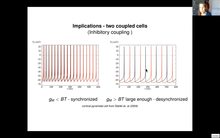The videos from Brain Day 2023 are now available on line at our youtube channel. Hope you enjoy.
Colloquia are generally on Tuesdays at 3:30 p.m., once per month. They are usually held in the Centre for Theoretical Neuroscience (CTN) seminar room (Psychology, Anthropology, Sociology building (PAS),
Room 2464; exceptions will be noted). Abstracts are posted as available. If you'd like to be on the mailing list announcing these events, please sign up here.
Here is a list of our upcoming speakers for the 2016-2017 academic year:
October 18, 2016 - Robert Jacobs (University of Rochester)
December 6, 2016 - Julio Martinez-Trujillo (Western University)
February 28, 2017 - Richard Staines (University of Waterloo)
March 13, 2017 - Ed Connor (Johns Hopkins University)
March 28, 2017 - Gunnar Blohm (Queens University)
April 5, 2017 - Waterloo Brain Day (11th Annual)
Date: Tues., Oct. 18, 2016
Location: PAS 2464
Time: 3:30 pm
Speaker: Robert Jacobs (University of Rochester)
Title: From Sensation to Conception: Theoretical Perspectives on Multisensory Perception and Cross-Modal Transfer
If a person is trained to recognize or categorize objects or events using one sensory modality, the person can often recognize or categorize those same (or similar) objects and events via a novel modality, an instance of cross-modal transfer of knowledge. How is this accomplished? The Multisensory Hypothesis states that people extract the intrinsic, modality-independent properties of objects and events, and represent these properties in multisensory representations. These representations mediate the transfer of knowledge across modality-specific representations. In this talk, I'll present two projects evaluating the Multisensory Hypothesis using experimental and computational methodologies. The first project examines visual-haptic transfer of object shape knowledge, and the second project examines a novel hidden (latent) variable model of multisensory perception. I'll also consider implications of an experiment demonstrating generalization from perception to motor production for our understanding of cross-modal transfer.
Date: Tues., Dec. 6, 2016
Location: PAS 2464
Time: 3:30 pm
Speaker: Julio Martinez-Trujillo (Western University)
Title: Mechanisms of Working Memory Coding in the Primate Brain: From Single Neurons to Neuronal Ensembles
Working memory is the ability to maintain and manipulate information that is not available to the senses during short time intervals. It is currently thought that working memory arises from the sustained activity of neurons selective for spatial locations, features, and complex objects in different areas of the primate brain. One issue that has been a matter of debate is what is the role of different brain areas in working memory coding. I will present data from electrophysiological recordings along the primate visual dorsal pathway during working memory tasks and compare the fidelity of working memory representations of spatial locations and features by single neurons amongst these areas. I will then focus on the prefrontal cortex and elaborate on how interactions between neurons shape the coding of working memory within this area, and how measurements of correlated activity can reveal important aspects of the dynamics underlying working memory coding. I will finally elaborate on the implications of these different findings for current models of working memory.
Date: Tues., Feb. 28, 2017
Location: PAS 2464
Time: 3:30 pm
Speaker: Richard Staines (University of Waterloo)
Title: Crossmodal Influences in Somatosensory Cortex: Interaction of Vision, Touch, and Attention
Date: Mon., Mar. 13, 2017
Location: PAS 2464
Time: 3:30 pm
Speaker: Ed Connor (Johns Hopkins University)
Title: Shape Information in the Primate Brain
We study neural coding of shape in the ventral pathway of primate visual cortex. Because natural shape is a virtually infinite domain, neural coding is sparse and difficult to define. To compensate, we use genetic algorithms to focus stimulus sampling on the response ranges of specific neurons. This yields datasets that can constrain quantitative models relating stimulus geometry to neural responses. In previous studies, we have used genetic algorithms to show how objects are encoded as configurations of 3D surface fragments and medial axis elements. In recent work, we have studied large scale shape coding of scenes and rooms in the ventral pathway. In both object and scene representation, neural coding dimensions reflect the geometry of the natural world and the information we need about it.
Date: Tues., Mar. 28, 2017
Location: PAS 2464
Time: 3:30 pm
Speaker: Gunnar Blohm (Queens University)
Title: Spiking Networks for Decision Making and Working Memory
Decision making and working memory are central to cognition. Working memory is the transient retention and manipulation of information that can then be used to make a selection among choices, i.e. a decision. I propose a unifying framework of neural dynamics that could underlie different key features of decision making (such as the speed-accuracy trade-off) and working memory (such as capacity, distractibility and overload). We developed spiking neural models that capture decisions and working memory independently or within the same network as a function of a single (cognitive) control parameter, which we propose to be distal network disinhibition. The predicted neural mechanisms are helpful in understanding canonical computations underlying a variety of cognitive process beyond decisions and working memory.







